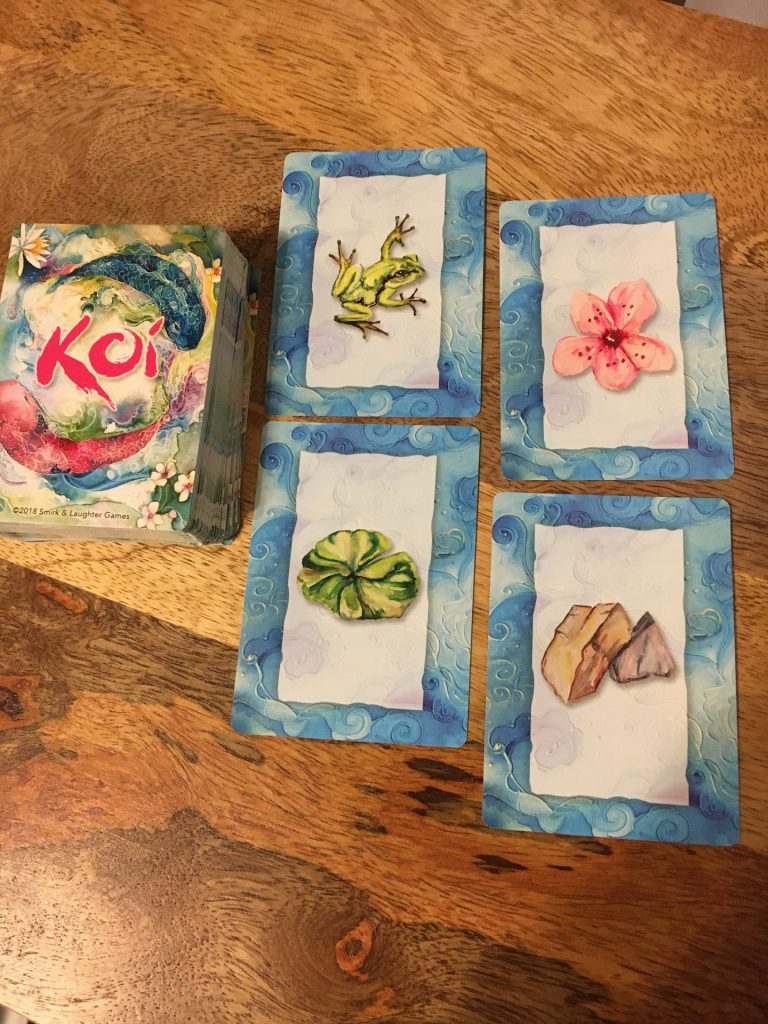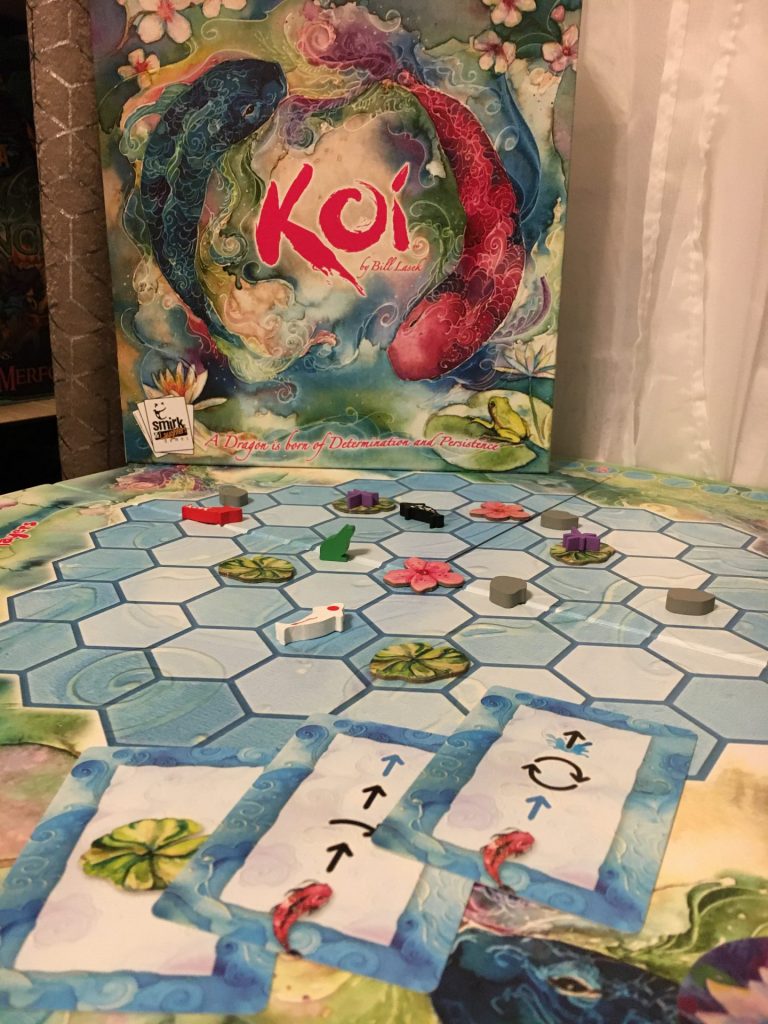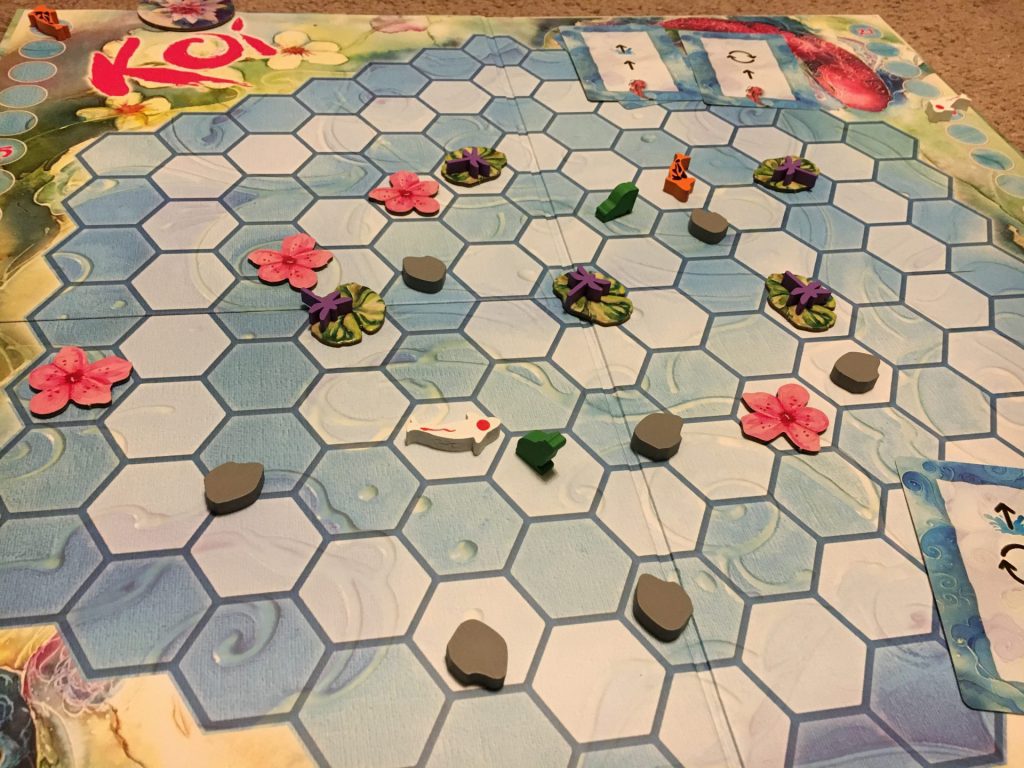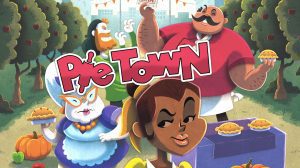Disclosure: Meeple Mountain received a free copy of this product in exchange for an honest, unbiased review. This review is not intended to be an endorsement.
Be the Big Fish in a Small Pond
The name of the game is Koi and in it you will experience one week in the life of a…well, Koi as you work to gain the most points by eating tasty dragonflies and frogs. The game plays over a series of 7 rounds (days) with each day having a unique weather card which affects gameplay in some way. Players will work through their randomly dealt hand of cards to maneuver their Koi, place tasty treats, or obstruct the way for their opponents. Do you have what it takes to outswim and outeat the competition?

Time to Get Snacking
In Koi, each player is working to maneuver their fish around the pond, dodging rocks and eating dragonflies and frogs to become the fattest fish of them all. This gluttonous romp may sound a bit simple, but it is far from an all-you-can-eat buffet. Dragonflies (worth 3 points) appear on lily pads floating around the pond only once per day and are a first-come, first-eaten commodity. These little guys are the main staple for gaining points in the game and are fought for and sometimes even sacrificed to other creatures of the pond just to keep them away from other hungry players’ scoreboards. Frogs are only worth 1 point when eaten, but they also enjoy an occasional snack of dragonflies.
Certain cards in the game will add frogs to the board, which can be used offensively and defensively. Frogs can be used effectively to gobble up the dragonflies that an opponent may have had their eye on. You can also simply drop a frog in your path for an easy point if you are feeling so inclined. This creates an ecosystem in the pond; you need to plan your card plays carefully to squeeze the most points out of your turns, but at the same time you need to plan how best to mess with your opponents to keep them from scoring big.
Be Careful with your Cards
The bread and butter of the gameplay in Koi is the cards so let’s spend a moment of time discussing them and what they do. There are two types of cards in Koi: natural beauty cards, which add terrain and animals to the board itself, and movement cards, which allow you to maneuver your Koi around the board.

Natural beauty cards are an interesting component in the game as they allow you to add everything from rocks to block your opponents’ path, to lily pads that attract more dragonflies in future rounds. You can even drop cherry blossoms into the pond that scare away all living creatures near them, creating some fun strategies for capturing prey or messing with opponents. These cards really allow you some control in how the pond shapes up and can give you an edge over your fellow fish.

The movement cards are what allow your Koi to embark on their journey to find food across the pond. Cards come in different styles but all will have some black-marked movements and some may have blue marks as well. You must always use the black-marked movement while all blue marks are optional. This gives you a bit of freedom on how you move around as you plan your route.
You are free to move anywhere you want in the pond, though you cannot move through rocks or share a space with other fish. If you do run into other fish you simply bump them and move them into an adjacent spot of your choice. You may also find some cards with a splash symbol. This will allow you to jump over the space directly ahead of your Koi, letting you leap across rocks or any other pesky nuisance. The direction you are facing is key in Koi as there are a lot of cards that dictate specific rotations you must take, which makes Koi very thinky as you work out the best route with the cards you have in hand.
One other important note is that while you may play any number of cards from your hand on your turn, you only draw three new cards per round so it is possible to quickly run out your hand. Having a limited number of options can really hurt you on a turn so it is important to weigh the cost of the cards spent against the points you are looking to gain. The use of the cards really is the core of Koi and was an enjoyable experience overall. I did find that you could get stuck with very useless options from time to time but there is a redraw option (though it effectively costs a card, which again quickly limits your options).
Final Thoughts

So is Koi a catch and release game or one to mount on the trophy wall? I have a few thoughts on this title about what makes it stand out and what might be a hurdle for some.
First, I love the art style represented here. Everything about this game is beautiful and almost gives off a tranquil air. Even the concept of the game puts me at ease. While it may be slightly strange that navigating my fish around a pond so it can chow down on helpless bugs and frogs relaxes me, Koi just puts me in a calm mood. If you are looking for other titles that exude a similar feeling, you may also enjoy Trellis or Tokaido
Second, the interplay in the “shared experience” of building the pond is very fulfilling. It is great fun blocking an opponent’s path with a perfectly placed rock or costing them many points with a strategically deployed frog who beats them to their tasty dragonfly prize. It is equally enjoyable to see these plans foiled with a well-played leap card that overcomes these challenges. While Koi can get a bit thinky with these mechanics, it is not overly so and is an enjoyable experience.
However, a potential downside to Koi is the way in which the first player passes around. The player with the lowest score goes first as a bit of a catch-up mechanic but is important to note the fourth player has a large disadvantage due to the lower amount of dragonflies they can hunt. Dragonflies are a limited resource with only one appearing per lily pad per round. Once eaten, they do not restock until the end of the round. I noticed that in some games we played, a certain player struggled to catch up in points and remained first player for a long period of time. This may not seem like a big deal but it did impact the game greatly as the second player, who was winning by a lot, still had a wide range of options to choose from. This set up of always being able to go second prevented myself or the fourth player from ever being able to catch up in points due to our slim choices of things left to eat.
This could have just been a small fluke in our sample size of games but I did notice that unless first player moved around frequently, this lopsided turn order affected the scores. I believe this could be fixed by seeing turn order rotate normally and perhaps allowing the player in last to draw additional cards above the allotted three to give them a chance to make big plays. The potential negative of the current turn system is that unless all players are at a somewhat equal skill level in Koi, the turn order mechanic may end up backfiring and aiding a certain player more than the others.

All things considered, I really enjoyed my time with Koi and was so grateful for the opportunity to relax and unwind pondside with this masterpiece. If you are looking for a gorgeous abstract title to add to your collection, you will not be disappointed with Koi.
Koi
Genre: Abstract
Pros: Beautiful art, thinky mechanics and interplay
Cons: Luck based card draws, Player skill impacts game experience.
Rating: 6/10 A quality offering that suffers from a modicum of luck mechanics.











Add Comment